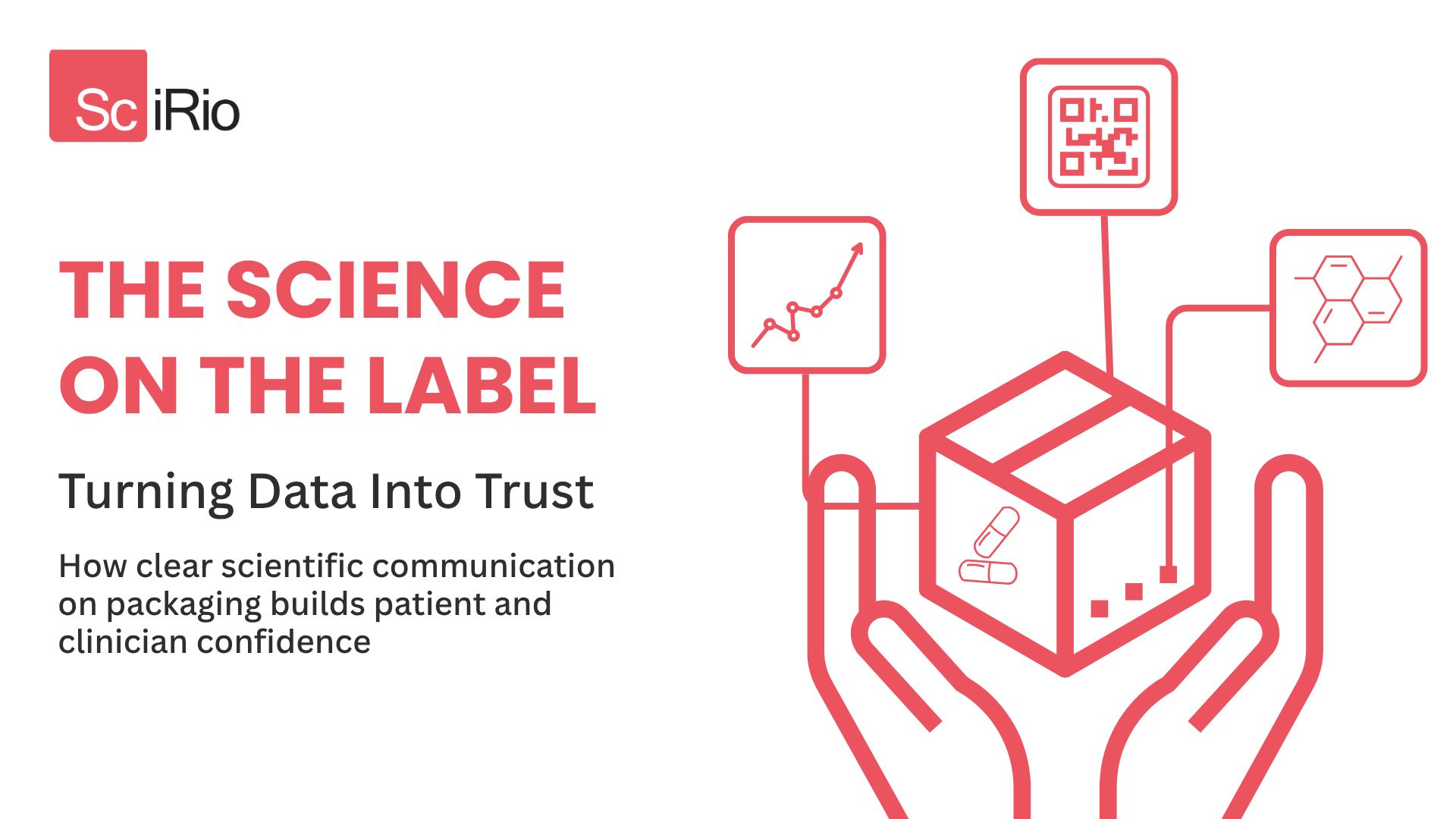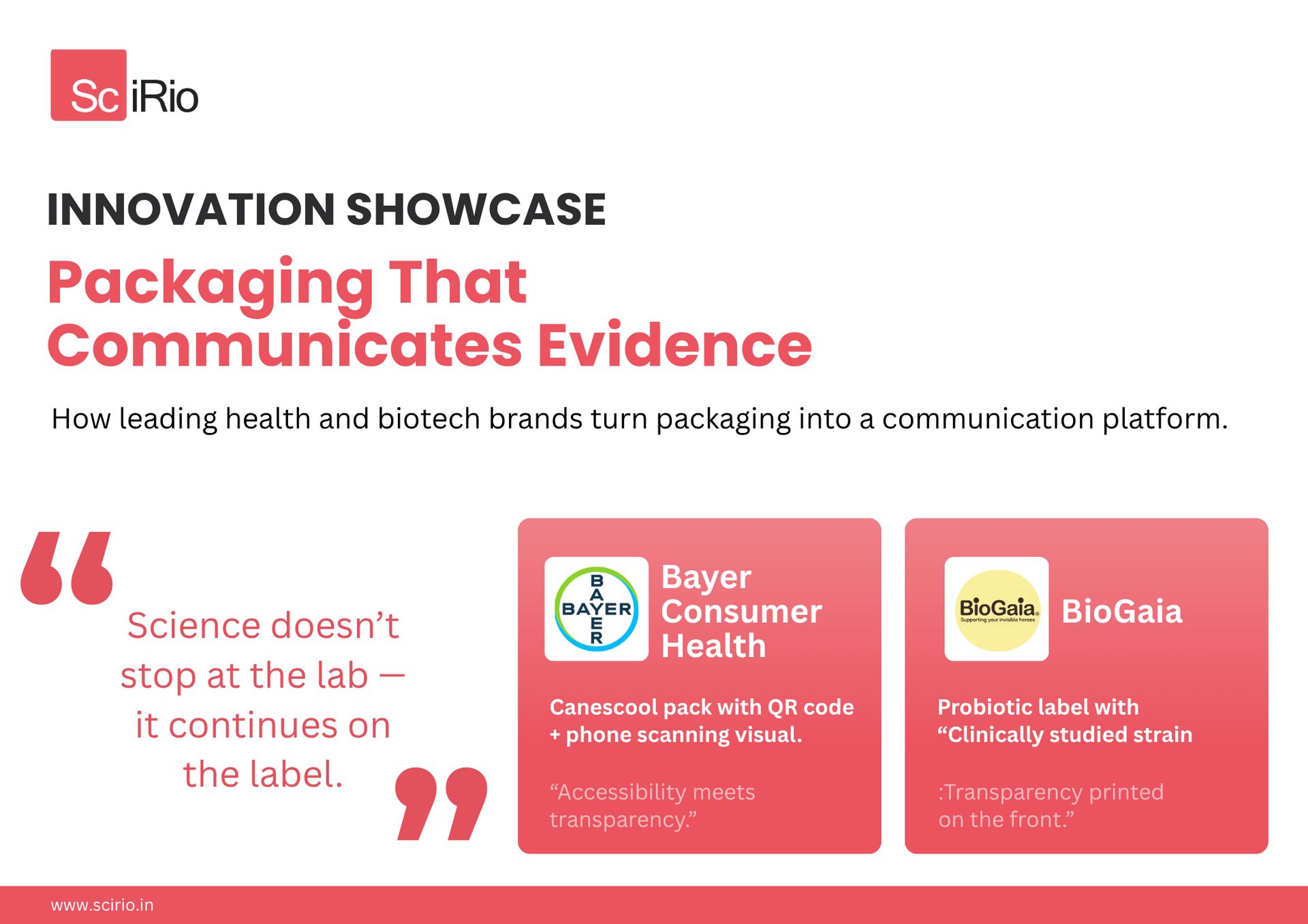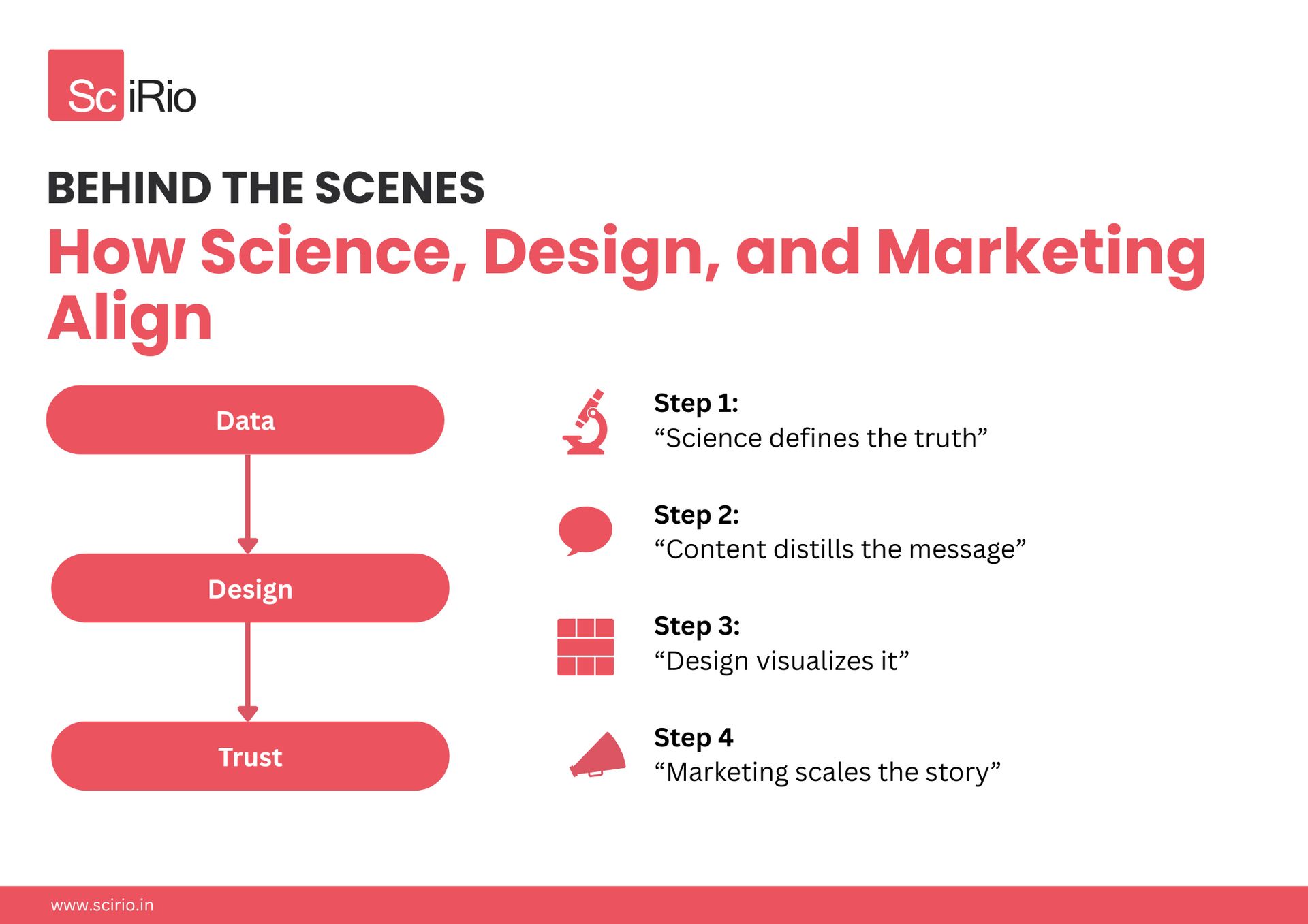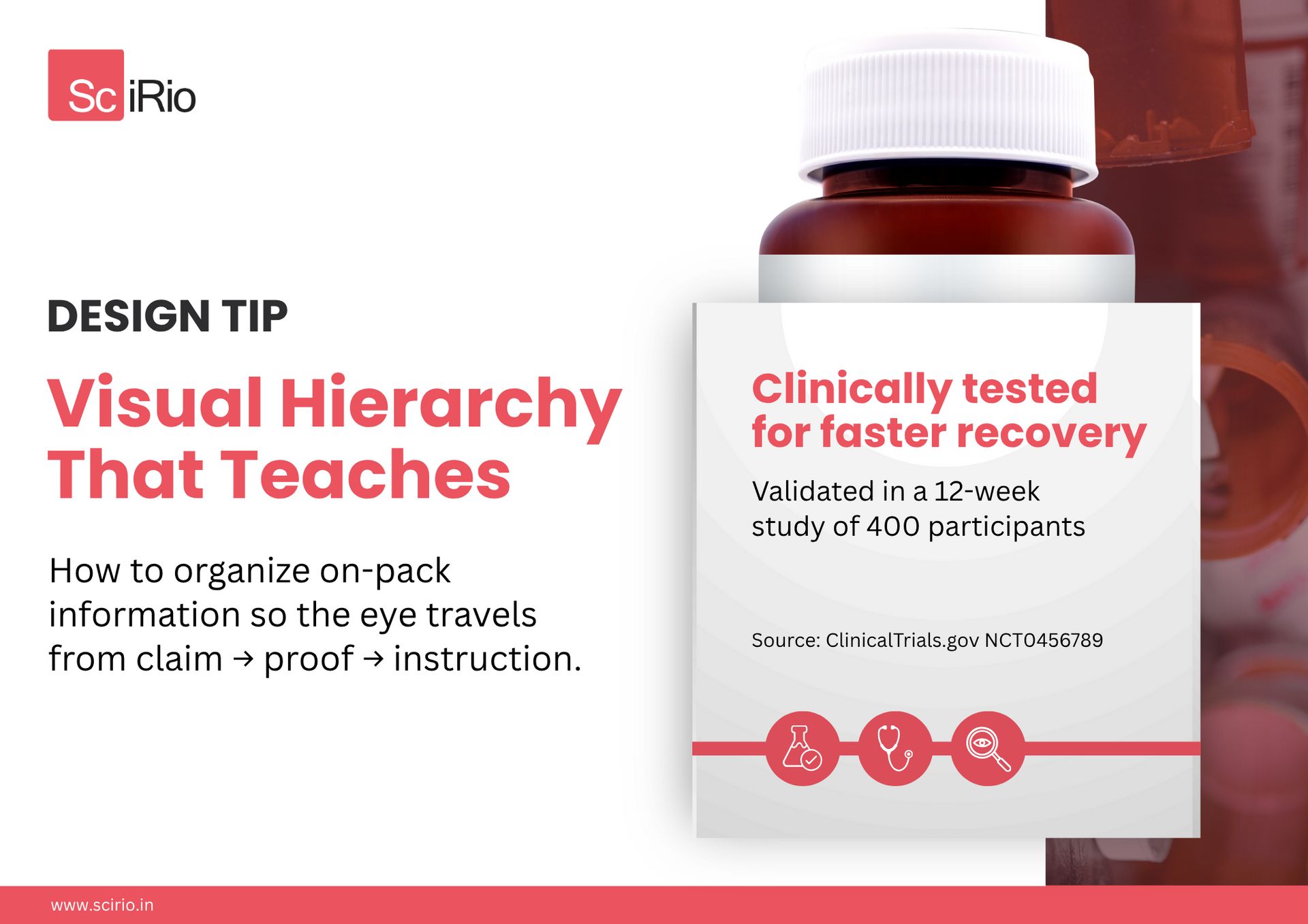- The Science Content Lab
- Posts
- The Science on the Label: Turning Data Into Trust
The Science on the Label: Turning Data Into Trust
How clear scientific communication on packaging builds patient and clinician confidence

Welcome, reader!
Before a clinician prescribes, before a patient opens the box — they read.
A label isn’t just a surface; it’s your most concentrated piece of science storytelling. It translates research, formulation, and clinical validation into one compact narrative of trust.
In health and biotech industries, where credibility lives or dies by clarity, good packaging turns data into confidence — helping people see the science and believe in it.
Featured Insight: From Fine Print to Proof Points
Science-backed packaging isn’t about adding more data — it’s about translating proof into meaning.
Studies show that simplifying structure and language on healthcare labels improves comprehension and reduces misuse (Aceves-González et al., 2024).
For clinicians, it supports faster interpretation; for patients, safer decisions.
Takeaway:
Every claim on the pack — “Clinically tested,” “Evidence-backed,” “Validated strain” — should link clearly to what that proof actually means for the user.
That’s how you turn fine print into proof points.

Innovation Showcase: Packaging That Communicates Evidence
Science doesn’t stop at the lab—it continues on the label.
Leading health and biotech brands are now treating packaging as a communication platform, not just a compliance form.
Bayer Consumer Health has launched the world’s first Accessible QR (AQR) code for healthcare packaging, beginning with its Canescool product in the UK. The code links directly to a digital information page with accessible text, voice options, and product details designed for all users (Bayer press release; GS1 UK case study).
While these digital leaflets focus on accessibility and comprehension today, the same format opens the door for tomorrow’s evidence-linked storytelling—where plain-language summaries and study visuals can live just one scan away from the product.
BioGaia continues to set the standard for scientific transparency in probiotics, printing “Clinically studied strain” directly on front-of-pack, signaling that claims are grounded in published trials (BioGaia products).
🧭 Science Communication Takeaway:
These examples show how thoughtful packaging can do more than list ingredients—it can extend scientific credibility beyond the journal page and into everyday use.
By merging clarity, accessibility, and evidence cues, brands are redefining what it means for packaging to “speak science.”

Practical Tools: For Packaging Storytelling & Science Clarity
These aren’t generic marketing apps — they’re practical workflows to help science, design, and communication teams co-create packaging that earns trust.
Challenge | Practical Tool or Approach | How to Apply in Packaging Context |
|---|---|---|
1️⃣ Turning study data into clear label copy | Use Notion AI or ChatGPT with your own product info to draft short, plain-language summaries (“What the study proved in 1 line”). | Feed it your technical summary → ask for a version written at Grade 8 reading level → refine tone for clinician or patient audiences. |
2️⃣ Checking real comprehension, not just readability | Run a label feedback sprint using UsabilityHub or Maze. | Upload your label mock-up → ask users “What do you think this product does?” or “How confident would you feel using this?” → measure clarity. |
3️⃣ Aligning science, brand, and regulatory language | Use a shared “Claim Bank” in Notion or Confluence. | Store all approved evidence-based phrases, so every department (R&D, marketing, legal) pulls from the same language. |
4️⃣ Making the invisible visible | Use Canva Pro or Figma to build evidence cards — small icons or infographics that visualize how the product works. | Create visuals like “How it helps” or “Proven in 3 studies” badges that fit the label design system. |
5️⃣ Testing real-world readability | Use Readable or Grammarly Business to score your label copy before printing. | Set a readability target (Grade 8–9 for general health; 10–11 for clinician-facing) and keep your most important phrase under 12 words. |
📍Bonus workflow idea:
Before your next product launch, schedule a one-day “Label Clarity Sprint” — where science, design, and brand teams co-review packaging language for understanding, tone, and visual flow. It’s fast, collaborative, and prevents overclaiming.

From the Field: Proven Practices in Label Communication
Consumer health — Sanofi
Sanofi Consumer Healthcare plans to make ingredient transparency a core part of its packaging strategy. By 2030, the company aims to disclose both active and inactive ingredients through QR codes on brand packaging linking to accessible web pages. This initiative is designed to “build trust, educate, and engage consumers” through clear on-pack science communication (Sanofi Consumer Healthcare Non-Financial Report, 2022).
Biotech nutritionals — DSM Nutritional Products
DSM’s Products with Purpose brand strategy focuses on translating scientific validation into consumer-friendly messages. Packaging and communication emphasize evidence-based benefits and plain-language proof of function, aligning science credibility with accessible storytelling (DSM press release, 2020).
Medical devices — Label usability standards
Across medtech, labeling clarity and iconography are increasingly recognized as safety enablers. Usability testing helps teams refine instruction flow, symbols, and hierarchy before launch, ensuring that packaging design supports accurate product use (Scilife overview, 2024).
Each example shows how science transparency is evolving into design clarity — turning labels into trusted bridges between data and understanding.

Behind the Scenes: How Science, Design, and Marketing Align
In strong science brands, the labeling process looks less like a regulatory checklist and more like a storytelling workflow:
1️⃣ Science defines the truth — summarize what’s actually proven.
2️⃣ Content teams find the signal — distill what matters most to end users.
3️⃣ Design turns it visual — use hierarchy, icons, and tone to communicate meaning quickly.
4️⃣ Marketing scales the message — extend that label clarity across digital touchpoints (website, e-label, sales kits).
When these functions collaborate early, packaging becomes more than packaging — it becomes a mini science explainer.
Over the past few months, we've been deep in the details of packaging development for several health and biotech clients, where every line, symbol, and phrase needs to carry scientific weight but also feel human.
It’s a surprisingly creative process. We start with long technical details — clinical validation, formulations, regulations — and the challenge is to ask: if someone only had five seconds to look at this pack, what truth should they walk away with?
From there, it becomes an exercise in micro-storytelling. We then distill the research into single, impactful taglines and align tone so that scientists, designers, and marketers are all speaking the same language.
What's become clear time and time again is that the strongest packaging is the one that teaches quickly and truthfully.

Design Tip: Visual Hierarchy That Teaches
Design is your second layer of scientific clarity.
Use visual hierarchy to guide how the eye travels from claim → proof → instruction.
Header: Simple benefit (“Clinically tested for faster recovery”).
Subtext: Context (“Validated in a 12-week study of 400 participants”).
Microcopy: Evidence link (“Source: ClinicalTrials.gov NCT0456789”).
Visual cues: Icons for steps, trust badges for validation, white space for readability.
🩺 Why it matters: In Systematic Reviews (2024), Saif et al. confirmed that clarity and iconography improve user confidence and interpretation of medical instructions (Saif et al., 2024).

Community Corner
“If you could redesign one element on your packaging to make it clearer — what would it be?”
Share your before/after examples on LinkedIn @SciRio —we’ll showcase the best real-world improvements in next month’s issue.
Missed our last issue? Read it here.
Final Word
Packaging is where your science goes public.
It’s the smallest, most visible proof of integrity your brand has.
When every word and visual choice builds clarity — not clutter — you transform your label from a compliance requirement into a trust signal.
Good science doesn’t just fit on a label — it speaks clearly from it.
SciRio’s blog
Science communication isn’t just a nice-to-have for researchers—it’s what helps your work truly make a difference in the world. This blog from SciRio explores why scientists should build communication training right into their career journey. You’ll find real talk on how mastering these skills lets you connect with all kinds of people, opens doors for new collaborations, and helps your research get the spotlight it deserves. Imagine being able to break down complex ideas for anyone—from policymakers to your neighbor—and watch your work reach even farther. If you’re curious (or maybe even skeptical) about why this matters, you’ll definitely want to check out the full story.
Ready to dive in? Get the full scoop here.